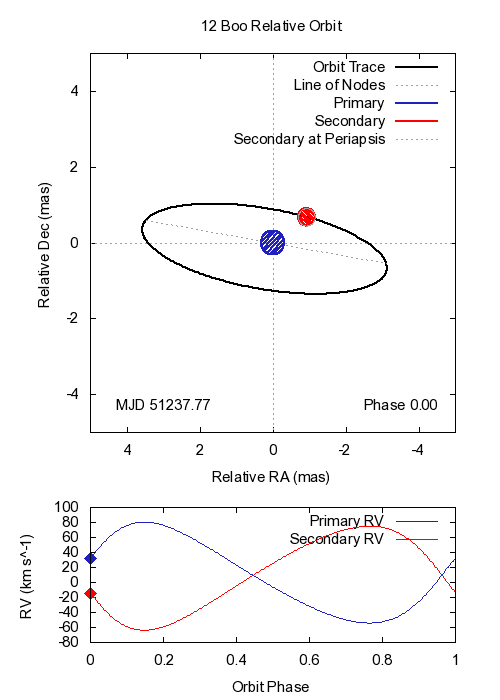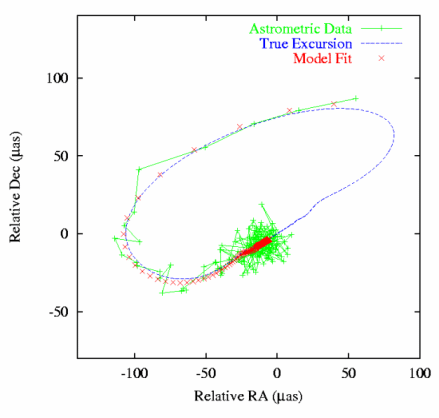Andy Boden's Scientific Interests
I've spent a good bit of my career working on long-baseline optical and near-IR
interferometers. So it stands to reason that I would be interested in
scientific problems these devices can address.
For up-to-date publication information please see
Andy Boden's ADS references.
Ground-based Interferometry
I'm a long-time collaborator on the Palomar Testbed
Interferometer (PTI), the Keck Interferometer (KI), and
I am peripherally associated with the CHARA Interferometric
Array at Mt. Wilson.
Binary Stars
A lot of what I've done with interferometers is study binary stars.
While traditional (read that boring), studies of binary stars
are important for at least two distinct reasons:

- Most stars form in multiple associations, so the
parameters of binary stars (e.g. period, eccentricity, mass ratio)
provide observational constraints to the star formation process.
- Binary stars are the hydrogen atoms of stellar
astrophysics; their gravitational interactions
are simple enough that the stellar kinematics can be inverted to
deduce fundamental parameters (most directly & uniquely, mass -- serving the
interests of the
Vogt-Russel Theorem)
of the stellar constituents themselves.
Besides, if you have an interferometer you have to study
binary stars -- it's a moral imperative. [That's a joke folks
-- see the work of some poor writer who reads personal web pages
rather than interviewing sources -- and who is apparently
humor-impaired!]
Several publications in the list below deal with precision
determinations of stellar properties from precision studies of binary
kinematics -- usually from integrating the results of
interferometric and spectroscopic observations. Shown at the right is
a cartoon of one of my favorite binary stars, 12 Bootis (HD 123999), a
pair of F stars in a 10 d orbit. Even though the two components of
the binary are nearly equal mass, there is a rough factor of two
difference in the brightness between the two stars -- because of
evolutionary effects (the primary is just leaving the main sequence).
The two frames of the animation show the relative astrometric and
radial velocity orbit of the binary respectively (see Boden, Torres,
and Hummel 2005). (Hit reload to run the animation again --
wahoo!). I would also call your attention to our work on pre-main
(PMS) sequence binaries (e.g. HD 98800 B (the first!) and
V773 Tau (the second!) PMS physical orbits done with long-baseline
interferometry), and high proper motion systems (e.g. HD 9939 -- old
(9.1 Gyr), yet remarkably metal-rich (solar)!)
Measurements like these help us better understand & constrain the
physics of how stars work and evolve. Since stars individually
or in ensemble are the fundamental observable objects in optical
astronomy, it is critical that our models of stars be as robust
and predictive as possible.
Circumstellar & Circumbinary Material in Binary Systems
Associated with binarity as a common product of the star
formation process, there are questions of the remaining material
in such systems. A natural outgrowth of our PMS work is study of
circumstellar and circumbinary material in some of these same
systems (e.g. HD 98800 -- Akeson et al 2007,
and DQ Tau -- Boden et al 2009). The stellar interaction with
and accretion from such material, as well as the possibility of
this material as the site for possible planet formation are
questions that are fascinating to many of us...
I am also a member of a team that recently
announced
the detection
of circumbinary dust around short-period main-sequence binary stars
(see Trilling et al 2007 below). Presumably this dust (in so-called
'debris disks') is produced (and continuously replenished) by
collisions of planetesimals orbiting the binary systems. Further, we
found that these debris disks were significantly more prevalent in
these short-period binaries than in comparable single stars. The
implications are profound: it could be that planetesimals -- and even
planets -- are common around binary systems!
Exo-Planetary Systems
A lot of us who work in optical interferometry in Pasadena have an
interest in exo-planetary systems. The idea that planets could be a
pervasive byproduct of the star formation process is attractive one,
and has rather profound implications on our place in the grand scheme
of things. We like to think of detecting and characterizing planetary
systems astrometrically. By measuring the transverse reflex
motion of the parent star one can uniquely determine the orbit
orientation (especially the all-important inclination Euler
angle) and thereby uniquely determine the planet mass rather than only
a lower bound on the mass from radial velocity detections.
I have been actively involved with developing relative astrometry
technology on the ground with PTI; we have been successful in
demonstrating 100 microarcsecond precision relative
astrometry on the visual binary 61 Cygni.
I am also a co-investigator on two SIM Key Projects to detect and
study exo-planetary systems. The first (EPICS -- PI Shao) will
astrometrically survey hundreds of stars down to a precision of a few
microarcseconds over a broad range of stellar primary types with a
goal of determining the architecture of planetary systems. The second
(SIM-YSO -- PI Beichman) will search for planetary companions to
pre-main sequence stars to study properties of young planetary
systems.
Galactic Dark Matter -- Gravitational Microlensing
 Gravitational lensing is a property of Einstein's theory of
gravitation, and indicates the presence of mass independent of
luminosity. Microlensing is gravitational lensing where the
individual images of the background source are unresolved by the
observer, and typically occurs when the lens is of stellar mass.
Astrometric or multiple-perspective observation of microlensing events
can break the degeneracies inherent in photometric-only observations
of microlensing events, and in particular uniquely determine the mass
of and distance to the lens.
Gravitational lensing is a property of Einstein's theory of
gravitation, and indicates the presence of mass independent of
luminosity. Microlensing is gravitational lensing where the
individual images of the background source are unresolved by the
observer, and typically occurs when the lens is of stellar mass.
Astrometric or multiple-perspective observation of microlensing events
can break the degeneracies inherent in photometric-only observations
of microlensing events, and in particular uniquely determine the mass
of and distance to the lens.
The figure at right (from Boden, Shao, and Van Buren 1998) depicts the
effects of astrometric gravitational microlensing. The two lensing
images change positions and brightness as a function of time. So even
though the images are not separately resolved, the photocenter of the
two images moves in an apparent elliptical excursion from the nominal
source position. (Departures from the elliptical pattern come from
the relative parallax between the lens and source.) By jointly
measuring the source photometric amplification and apparent
astrometric excursion the lens mass and distance are determined
uniquely.
I am a co-investigator on a SIM Key Project (SIM Microlensing Key
Project -- SMKP -- PI Gould) to measure both the mass function of the
Galactic bulge using microlensing events, and to unequivocally
establish the Galactic halo nature (or not) of the photometrically
detected events seen toward the LMC and SMC.
I am a member of a team that recently
announced the first
parallax measurement for a lens object (see Dong et al 2007 in the
publication list below). For this we used ground-based observations
and observations from the Spitzer Space Telescope.
Selected Publications
-
Interferometric Evidence for Resolved Warm Dust in the DQ Tau System, A. Boden, R. Akeson, A. Sargent et al 2009, ApJ 696L, 111
-
Dynamical Masses for Pre-Main Sequence Stars: A Preliminary Physical Orbit for V773 Tau A, A. Boden, G. Torres, A. Sargent et al 2007, ApJ 670, 1214
-
First Space-Based Microlens Parallax Measurement: Spitzer Observations of OGLE-2005-SMC-001, S. Dong, A. Gould, W. Reach et al 2007, ApJ 664, 862
-
Debris Disks in Main-Sequence Systems, D. Trilling, J. Stansberry, K. Stapelfeldt et al 2007, ApJ 658, 1289
-
The Circumbinary Disk of HD 98800B: Evidence for Disk Warping, R. Akeson, K. Rice, A. Boden et al 2007, ApJ 670, 1240
-
A Physical Orbit for the High Proper Motion Binary HD 9939, A. Boden, G. Torres, & D. Latham 2006, ApJ 644, 1193
-
Dynamical Masses for Low-Mass Pre-Main-Sequence Stars: A Preliminary Physical Orbit for HD 98800 B, A. Boden, A. Sargent, R. Akeson et al 2005, ApJ 635, 442
-
Testing Stellar Models with an Improved Physical Orbit for 12 Bootis, A. Boden, G. Torres, & C. Hummel 2005, ApJ 627, 464
-
Interferometric Measurement of the Angular Sizes of Dwarf Stars in the Spectral Range K3--M4, B.F. Lane, A.F. Boden, & S.R. Kulkarni 2001, ApJ 551, L81.
-
Orbital and Stellar Parameters of Omicron Leonis From Spectroscopy and Interferometry, C.A. Hummel et al 2001, AJ 121, 1623.
-
A Preliminary Visual Orbit of BY Draconis, A.F. Boden and B.F. Lane 2001, ApJ 547, 1071.
-
Interferometric Observations of the Cepheid Zeta Geminorum, B.F. Lane,
M.J. Kuchner, A.F. Boden, M. Creech-Eakman, & S.R.Kulkarni 2000,
Nature, 407, 485.
-
The Visual Orbit and Evolutionary State of 12 Bootis, A.F. Boden, M. J. Creech-Eakman, and D. Queloz 2000, ApJ 536, 880.
-
The Visual Orbit of iota Pegasi, A.F. Boden et al (The PTI Collaboration) 1999, ApJ 515, 356.
-
An Interferometric Search for Bright Companions to 51 Pegasi,
A.F. Boden et al (The PTI Collaboration) 1998, ApJ 504, L39.
-
Astrometric Observation of MACHO Gravitational Microlensing, A.F. Boden, M. Shao, and D. Van Buren 1998, ApJ 502, 538.
-
Massively Parallel Spatially-Variant Maximum Likelihood Restoration
of Hubble Space Telescope Imagery,
A.F. Boden et al 1996, JOSA A V 13 No 7, 1537.
CV
My CV in PDF...
Acknowledgments
I am very happy to acknowledge financial support from the
NSF
and NASA
/Spitzer Science Center and
COO.
Back to A.B.'s Home Page

 Gravitational lensing is a property of Einstein's theory of
gravitation, and indicates the presence of mass independent of
luminosity. Microlensing is gravitational lensing where the
individual images of the background source are unresolved by the
observer, and typically occurs when the lens is of stellar mass.
Astrometric or multiple-perspective observation of microlensing events
can break the degeneracies inherent in photometric-only observations
of microlensing events, and in particular uniquely determine the mass
of and distance to the lens.
Gravitational lensing is a property of Einstein's theory of
gravitation, and indicates the presence of mass independent of
luminosity. Microlensing is gravitational lensing where the
individual images of the background source are unresolved by the
observer, and typically occurs when the lens is of stellar mass.
Astrometric or multiple-perspective observation of microlensing events
can break the degeneracies inherent in photometric-only observations
of microlensing events, and in particular uniquely determine the mass
of and distance to the lens.